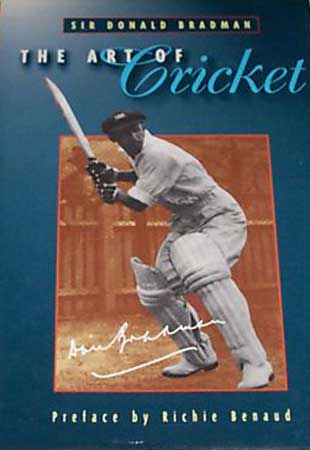Bradmanesque
Like his batting, the Don's book lacks flourishes, is exceedingly effective, and is easily the final word on cricket coaching
Suresh Menon
31-May-2008
|
|
 |
This is not merely the finest book on coaching. It takes us closer into the mind of a great batsman than autobiographies or biographies tend to. Even a casual reading hints at the amount of thought that went into Bradman's cricket; and the continuum between life and cricket. Open the book anywhere, and you come across advice that is applicable equally to both. "Watch and learn from others," it says at one point. "Don't be afraid of trial and error." It is advice to a bowler; it could be the theme at a university convocation.
Much like Bradman's batting, famously characterised by Neville Cardus as lacking in flourishes, The Art of Cricket is effective without being literary, sound without being showy, and gains from a mixture of common sense and sheer authority. The student is reassured by the unstated response, "If it worked for Bradman ..."
At the first World Cup, in 1975, the Australian medium-pacer Gary Gilmour claimed 6 for 14 against England in the semi-final. That was remarkable enough. What was even more so was his admission that he had never been formally coached but had learnt his cricket from reading The Art of Cricket.
In the four decades that the book has been the final word on coaching, no one has paid it a better tribute than Richie Benaud, who wrote that Bradman had "managed to slice through the rhetoric of cricket coaching to produce a book that is able to be perfectly understood by pupil and teacher, a trait in modern-day coaching which does not necessarily apply".
The insights into Bradman alone make this a worthwhile read. After suggesting an alternative to the pull shot, Bradman says, "But it has its risks, especially when the ball is coming in towards the body." And then he asks the question that gives us a peep into his soul: "... but then who wants to play cricket at all if not prepared to take a chance occasionally?" He does advise caution, though: "Don't try the pull shot on a greasy pitch after a shower of rain. Or if you do, have a spare set of teeth ready."
Few sports reveal character in the manner cricket does. It is a complex, multi-layered ritual. The Art of Cricket suggests that some of the complexity is merely an aggregate of simplicities. And that is the secret of this book's enduring power; it simplifies a form, unlike many of its successors that put off the reader by making the explanations more esoteric than the crafts themselves.
From the book
My movements at the crease prior to the bowler delivering the ball depended on the type of bowler operating. I was never conscious of a precise and predetermined movement, but slow motion pictures of me batting, both in matches and in demonstration films, prove conclusively that I always begin lifting the bat just prior to the ball being delivered. At the instant of delivery, the bottom of my bat was usually almost level with the bails and against fast bowlers, my rear foot was already in the process of shifting back and across.
My movements at the crease prior to the bowler delivering the ball depended on the type of bowler operating. I was never conscious of a precise and predetermined movement, but slow motion pictures of me batting, both in matches and in demonstration films, prove conclusively that I always begin lifting the bat just prior to the ball being delivered. At the instant of delivery, the bottom of my bat was usually almost level with the bails and against fast bowlers, my rear foot was already in the process of shifting back and across.
The Art of Cricket
by Donald Bradman
Hodder & Stoughton, Sydney, 1960
by Donald Bradman
Hodder & Stoughton, Sydney, 1960
Suresh Menon is a writer based in Bangalore